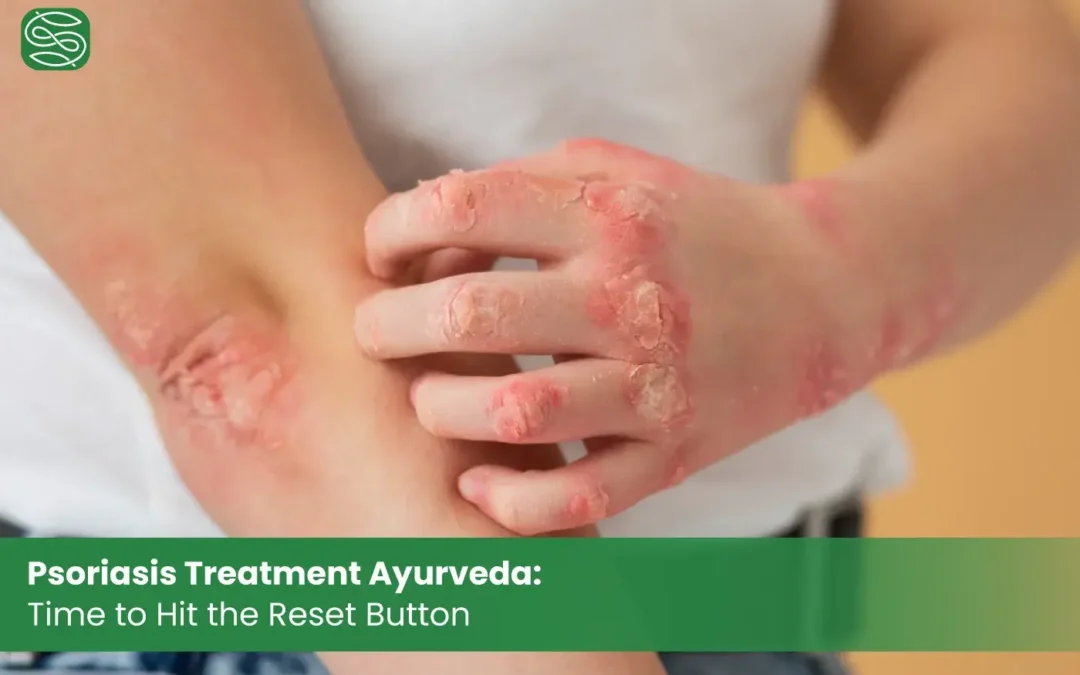Psoriasis is commonly referred to as a skin condition, a long-lasting, recurring disease characterized by inflamed, scaly patches that can be itchy, burning, and/or cracking. However, anyone who has experienced it knows that Psoriasis is much more than something that is “skin deep.”
Within Psoriasis treatment ayurveda, that deeper view is not just a belief; it is the basis for treatment and healing of the body. Rather than considering Psoriasis a disease itself, Psoriasis is treated as a symptom of imbalance in the system. The most effective way to restore the balance in the system is not to suppress the patches but to press the “reset” button of the body. That reset, called Panchakarma, a foundation of psoriasis treatments in Ayurveda, which allows the body to detoxify and restore its original state of balance.
Psoriasis Is Not a Glitch, It’s Corrupted “Code”
Imagine your body as a sophisticated piece of software. Every cell, hormone, and immune messenger is like a line of code, communicating with each other in order to keep things calibrated and harmonized. Psoriasis, in comparison, is not an escalation or random infection; it is ultimately buggy code or what we refer to as a code defect. Your immune system, designed to protect your body, is sending incorrect messages that cause skin cells to multiply too quickly, leading to inflammation.
Treatment of Psoriasis Ayurveda identifies that the type of degeneration is due to specifically to excess Ama (toxins), agitated Agni (digestive fire), and agitated Doshas, specifically Vata and Kapha. Traditional treatment focuses on the skin’s external manifestations to manage the complications of inflammation, scaling, and itching. Ayurveda dives deeper. It seeks to rewrite your particular internal “code” so the system doesn’t create buggy internal code at all. The best way to achieve this is a structured detoxification and reset, such as with the use of Panchakarma, the foundation of Ayurveda’s method for the treatment of Psoriasis.
What it Really Does: Cleaning Up Biological Code in Psoriasis Treatment Ayurveda
Panchakarma means “five actions.” It describes a series of therapies that are inherently cleansing and restorative, removing toxins, rebalancing the doshas as well as restarting the body’s internal messaging. But, it is not simply a detox; it can be understood as a biological debugging system, removing what should not be there, and returning what should be.
Here’s how the five primary therapies can be understood as a system overhaul in Psoriasis Treatment Ayurveda:
- Vamana (therapeutic emesis) – Vamana is aimed at excess Kapha, helping to eliminate mucus and metabolic wastes, along with deeply embedded toxins, from both the respiratory and digestive tracts. This thereby reduces the inflammatory load and improves skin metabolism in Psoriasis patients.
- Virechana (therapeutic purgation) – This therapeutic form is directed at purging excess Pitta, while also helping to eliminate toxins from the liver, gallbladder, and intestines. Given that Virechana detoxifies blood and liver, it is an essential in the therapeutic intervention for decreasing systemic inflammation, as it removes toxins accumulated in the blood and liver.
- Basti (Medicated enema) – Performed for balancing Vata, Basti improves nervous system support, hormone regulation, and gut function. Basti supports both nutrient absorption and immune function, which are key to maintaining healthy skin-immune balance. This makes it an important part of managing psoriasis holistically.
- Raktamokshana (Bloodletting or Blood purification) – Another detoxification (and blood cleaning and/ or blood purification) therapy, Raktamokshana helps cleanse and purify the blood, removing hidden toxins that can cause inflammation and skin conditions like psoriasis. Balancing the reaction of toxins in the system blood is likely to control future psoriatic flares and improve the overall texture and tone of the skin.
- Nasya (Nasal therapy) – Nasya involves administering medicated oils or herbal drops through the nose. It helps balance hormones, boost immunity, and support skin health by clearing toxins from the head and neck region.
Instead of simply treating the surface symptoms like psoriasis patches, Ayurveda focuses on restoring internal balance by correcting the body’s immune signaling to the skin. This holistic approach supports long-term healing, which is why it remains a key treatment in both classical Ayurvedic literature and modern clinical care for psoriasis.
From Inflammation to Information: How Psoriasis Treatment Ayurveda Re-Educates Your Body
The most powerful outcome of Psoriasis Treatment Ayurveda is not just detox, it’s awareness. The body relies on external signals to function normally. If toxins accumulate and doshas become imbalanced, these signals become disrupted. Psoriasis is caused when the immune system cannot properly tell the difference between harmful substances and the body’s own cells, which leads to ongoing inflammation.
Panchakarma can turn this around by internally correcting the state of disorder:
- Supports Immune Balance: Removing toxins and clearing metabolic waste in the blood reduces inflammation in the immune system, resulting in fewer and less severe psoriasis flare-ups.
- Aids in Toxin Elimination: When Ama is eliminated, the sources of inflammation in the skin can heal tissue effectively, rather than inflaming them.
- Promotes Gut-Skin Balance: In Ayurveda, skin health is closely linked to gut health. Cleansing the gut helps improve digestion, nutrient absorption, balance of gut bacteria, and immune function.
It enhances the body’s immunological perception, instructing it to react in proportion, rather than overreact. That is why numerous patients notice that improvements are not just limited to their skin but also in digestion, mood, energy levels, and immunity.
The Aftermath: What a Reset Body Does Differently in Psoriasis Treatment Ayurveda
There is a significant difference in the state of a body suffering from Psoriasis and one that has undergone Panchakarma. The body functions differently on every level following detoxification and dosha balancing.
- Fewer Flare-Ups: Because the body has fewer toxins and a less reactive immune system, it has fewer flare-ups, and when flare-ups do happen, they’re less intense.
- Faster Healing: With the normalization of skin cell turnover, reduced inflammation, and increased healing ability of pre-existing lesions, the patient still notices marked improvement.
- Supports Blood Cleansing: Blood purification therapies, such as Raktamokshana, provide immediate clarity to the skin, vitality, and reduce inflammatory mediators that circulate in the blood.
- Calmer Inflammation: Systemic inflammation decreases throughout the body, not just in the skin, meaning a much healthier state for the body overall.
- Supports Immune Stability: A balanced immune system will prevent unintentional “attacking” on the skin, allowing patients to experience more extended periods of remission.
This shift is why Psoriasis Treatment Ayurveda prioritizes treating Psoriasis from within. When the internal environment improves, the skin follows suit, proving that healing occurs beneath the surface.
Building a New Baseline:
One of the fundamental principles of Ayurveda is that healing is not something that happens once but a rhythmic process. Panchakarma is not a single cleanse, but a first step in a new body baseline. Once the body has been detoxified initially, maintenance can be achieved through seasonally repeated treatments, a regulated diet, and lifestyle changes to ensure inner equilibrium.
For Psoriasis patients, this translates to normalcy of remission, not an exception. Regular Panchakarma maintains the doshas in balance, avoids toxin buildup, and regulates the skin-immune system. It turns Psoriasis into a manageable disease from one of long-term misery.
Conclusion
Psoriasis may appear on the skin, but its origin lies deep within the immune system, blood, and gut. While modern treatments focus on symptoms, Ayurveda works at the root. At Shathayu Clinic, Panchakarma is the key Ayurvedic therapy used to restore internal balance and support lasting skin health.
It’s not a simple detox but a biological reset, clearing toxins, restoring natural intelligence, and helping the body heal from within. For psoriasis care, it marks the turning point when the body stops reacting against itself and begins to repair and renew naturally.
1. How does Ayurveda treat psoriasis differently from modern medicine?
Ayurveda treats psoriasis by balancing Vata and Kapha doshas and detoxifying the body through Panchakarma, instead of only managing skin symptoms.
2. What is the duration of Ayurvedic treatment for psoriasis?
Depending on severity, a Panchakarma program may last 21–45 days, followed by diet and lifestyle support for sustained remission.
3. Can Ayurveda cure psoriasis permanently?
Ayurveda focuses on long-term remission by addressing the root causes, toxins, digestion, and immunity, helping prevent flare-ups and recurrences.
4. Which Ayurvedic oils are good for psoriasis?
Commonly used oils include Mahatiktaka Taila, Nimbadi Taila, and Karanja Taila, which soothe itching and inflammation while supporting skin renewal.
5. When should I consider Panchakarma for psoriasis?
If psoriasis is chronic, recurrent, or resistant to topical treatments, Panchakarma is recommended for deep detoxification and immune reset.

